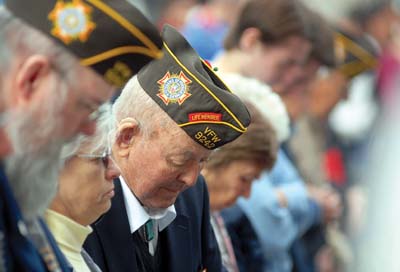In Lauren Topazian’s fifth-grade classroom, the walls are covered with artifacts of ancient civilizations. But today she is asking her students to put themselves somewhere far less exotic: in their classmates’ shoes.
In Lauren Topazian’s fifth-grade classroom, the walls are covered with artifacts of ancient civilizations. But today she is asking her students to put themselves somewhere far less exotic: in their classmates’ shoes.
The youngsters are acting out scenarios that call for offering friends a little extra support – such as when a pal loses an art contest or is the target of a rumor. The role-playing speaks volumes about the culture at Cossitt School in La Grange, Ill., where thinking about how your behavior affects others is as much a part of the day as reading and math.
“You can’t just assume kids know how to show kindness or resolve conflict,” said Principal Mary Tavegia. “You’ve got to give them the tools as soon as they walk in the door.”
In 2004, Illinois became the first state in the nation to require all school districts to teach social and emotional skills as part of their curriculum and daily school life. That means students are expected to meet certain benchmarks, such as recognizing and managing feelings, building empathy and making responsible decisions.
And the touchy-feely stuff doesn’t have to come at the expense of intellect. New evidence shows a strong link between interpersonal skills and academics, said Roger Weissberg, a professor of psychology at the University of Illinois Chicago, who has studied social and emotional learning for more than 25 years.
Weissberg and his colleagues recently completed an analysis of 300 scientific studies and reached two important conclusions: Students enrolled in such programs scored at least 10 percentage points higher on achievement tests than peers who weren’t. At the same time, discipline problems were cut in half.
“Some teachers may be skeptical about (Social and Emotional Learning) at first, but they are won over when their students learn more, are more engaged and better problem solvers,” said Weissberg, president of CASEL, the Collaborative for Academic, Social and Emotional Learning, based at UIC. The non-profit promotes the benefits of acquiring such abilities, from pre-school to high school.
Few schools embrace the philosophy as robustly as Cossitt School, which Weissberg called “a national model.”
Tavegia’s passion for the subject started in the mid-1990s, following a survey that revealed students didn’t feel connected to the school, the staff or each other.
“It was a real eye-opener,” she admitted. “Here we thought we were living in Mayberry, and discovered that we weren’t.”
So she started viewing every minute of the school day as an opportunity to build a foundation that will help students navigate sticky situations that arise in and out of the classroom.
“It is woven into everything we do,” she said.
So in science lab, class begins with a discussion not just on molecules, but what makes a good partnership. It ends with students reflecting on how the experiment worked – but also how well they met their social goals. In language arts, the teacher will often go beyond basic comprehension questions about a story, asking students to accept that different characters might view the same incident differently.
And sometimes, that means the kind of role-playing going on in Topazian’s class, where pupils are acting out a variety of conflicts. The students’ all-purpose fix to the problems? Ice cream.
Mediating problems won’t always be so easy for kids, but practicing now helps stack the deck in their favor, explained Joan Duffell, president of Committee for Children, a Seattle-based nonprofit that developed the Second Step, one of the programs used at Cossitt and dozens of other Chicago area schools.
“In a perfect world, parents would teach these skills … but it doesn’t always work that way,” Duffell said. “Even in the finest schools, classroom management is a problem. You can throw millions of dollars at a great math program, but if the classroom is out of control and the teacher can’t teach…then the best curriculum in the world won’t improve your scores.”
The need to create caring school communities has never been greater, say experts. Whether it was the Columbine, Colo., school shootings more than a decade ago or the Sept. 22 suicide of an 18-year-old gay college freshman whose tryst was streamed live on the internet, each tragedy prompts a fresh round of shock and bewilderment.
Bruised feelings, rude jabs and hallway shoves have always been a part of the pre-teen and adolescent landscape, but a growing body of dispiriting statistics confirms that bad behavior is on the rise and more psychologically harmful than what was endured by earlier generations.
In the 2009 School Crime and Safety report, assault and theft have declined, but bullying and verbal abuse increased. About 32 percent of middle and high school students say they’ve been bullied during the year compared to 5 percent in 2000.
Some say the kids are just reflecting a general coarsening of society, from trash-talking celebrities to boorish politicians. And, of course, there’s the pervasive use of technology, which is often beyond the reach of school authority. Young people, ages 8 to 18, now consume more than 7 1/2 hours of media a day, according to the Kaiser Family Foundation. That’s a heavy diet of cyber comments – even voting – about who is “fat” or “gay”, which can spread throughout school with a keystroke.
It’s easier to manage behavior by being proactive rather than reactive, say proponents. There are dozens of such interventions – with names like Second Step and Seeds of Empathy. The message is anti-bullying and anti-drug, but it’s much more, from recognizing internal cues to cultivating optimism.
Since 2007, the Illinois State Board of Education has distributed about $1.4 million in grants to 37 school districts solely for this purpose.
Courtney Orzel, principal of Jack Hille Middle School in Oak Forest, acknowledged some skepticism when her school implemented social and emotional learning four years ago. Since then, “everything has improved…our test scores, the climate of our building, our parent communication,” she said. “There’s been a huge shift of where we were and where we are now.”
Beyond playground politics, developing coping strategies now can be an inoculation against setbacks later, whether that’s a layoff, a vanishing 401K or divorce, experts say.
Still, the programs can be a tough sell. “It’s true that not everyone is on board and that saddens me,” Orzel said. “It’s really about supporting the whole child.”
As a mother of four, Marcy Dunne doesn’t need data to know what works. Her kids – ages 9 to 15 – are current and former Cossitt students, and she revels in the moments when she catches them doing good, such as a play date with a special needs child.
“This is not just a passing thing…these values really stick with them through the years,” Dunne explained. “And at the end of the day, these are the qualities that are going to make them successful and determine what kind of person they grow up to be.”
For now, such know-how can come in handy, said a group of Cossitt sixth-graders.
When they see someone from a different school tease another student, “it makes us feel bad,” said Avery Herndon.
For the tormentor or the victim? “Both,” she said.
Patrick King used his competency to deflect wisecracks about his height. “Kids call me leprechaun or midget … and I just ignore it. I know I’ll be taller one day.”
To be sure, Cossitt students aren’t perfect. Kids here are excluded from birthday parties and sleepovers – just like everywhere else.
“But we keep (talk of the parties) to ourselves,” Grady Davis explained. “We don’t talk about it in front of them.”
Next year, that all might change. This group will move on to middle school, where friendships get reshuffled and the pal who once saved you a spot at the lunch table may now act as if you’re invisible.
“It’s going to be different, and it’s going to be hard,” acknowledged Yaman Kelemet. “But I’m going to try really, really hard to remember all the lessons I’ve learned here.”








